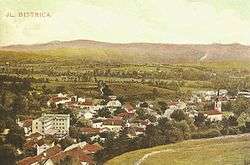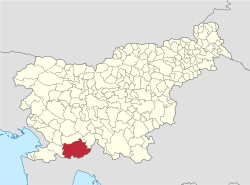Ilirska Bistrica
| Ilirska Bistrica | |
|---|---|
|
1910 postcard | |
 Ilirska Bistrica Location in Slovenia | |
| Coordinates: 45°34′4.46″N 14°15′9.69″E / 45.5679056°N 14.2526917°ECoordinates: 45°34′4.46″N 14°15′9.69″E / 45.5679056°N 14.2526917°E | |
| Country |
|
| Traditional region | Inner Carniola |
| Statistical region | Littoral–Inner Carniola |
| Municipality | Ilirska Bistrica |
| Area | |
| • Total | 34.8 km2 (13.4 sq mi) |
| Elevation | 421.2 m (1,381.9 ft) |
| Population (2012) | |
| • Total | 4,539 |
| Climate | Cfb |
| [1] | |
Ilirska Bistrica (pronounced [iˈliːɾska ˈbiːstɾitsa]; German: Illyrisch Feistritz; Italian: Villa del Nevoso, before 1927: Bisterza) is a town in the Inner Carniola region of southwestern Slovenia. It is the administrative seat of the Municipality of Ilirska Bistrica.
Name
The name Ilirska Bistrica means 'Illyrian Bistrica', it has its origin during the times of the Austrian Empire, when the area was part of the Kingdom of Illyria, an administrative unit between 1816 and 1849. The adjective Ilirska (Illyrisch) was added to the old name Bistrica (Feistritz) to differentiate it from other towns in the Empire such as Slovenska Bistrica or Banská Bystrica in modern-day Slovakia.
The town's coat of arms represents the history of the region, recalling the pre-Slavic Illyrian people that once populated the area, along with their shipbuilding past. The town's current coat of arms was adopted in the mid-19th century and is only a slight modification of the coat of arms of the Kingdom of Illyria.
Geography
The town centre is located on the ancient road from Postojna and Pivka to Rijeka on the Adriatic coast. It is situated in the valley of the Reka river, on the steep rim of the densely wooded Snežnik plateau in the northeast. In the southwest, the Brkini Hills form the natural border with the Slovene Littoral (Slovene Istria) historical region.
History

In the 12th century a fortress was erected at the site of a prehistoric settlement on a hill east of the town centre, when the area was part of the Imperial March of Carniola. The castle later was held by the Counts of Duino, from the 14th century onwards by the princely House of Auersperg in Postojna.
The settlement of Bistrica itself was first mentioned about 1300; its advantageous location, the surrounding karst springs and extended forests promoted the economic development of numerous sawmills and a flourishing timber trade from the early 15th century onwards. With the Duchy of Carniola, the town for centuries was part of the Habsburg Monarchy. In the 19th century, the Bistrica wood merchants mainly supplied the Austrian seaports of Trieste and Rijeka. In 1873 a railway line was opened by the Austrian Southern Railway company, running from Pivka and the Southern Railway line via the Ilirska Bistrica railway station to the coastal cities of Opatija and Rijeka.
Within the last 100 years, the town's history has been primarily shaped by the nations that have occupied it. Bistrica has been under the control of the Austro-Hungarian Empire since 1867, was annexed by the Kingdom of Italy in 1920, it became part of Yugoslavia after World War II and finally of independent Slovenia. Remnants of this can still be seen in numerous monuments, the railway station, and the Italian barracks from the Second World War.
During last days of World War II LXXXXVII Army Corps (97th Army Corps) under command of German General der Gebirgstruppe Ludwig Kübler were defending defensive area between Rijeka and Snežnik, also known as "Ingridstellung" or defensive line Ingrid. Their task become halting Yugoslav advance towards Trieste and Ljubljana threatening rear of both Army Groups C and E. LXXXXVII Army Corps became encircled in area around Ilirska Bistrica and Snežnik, when Tito ordered 4th Army to bypass 97th Corps and capture Trieste. Only after Partisan captured Trieste was the 97th Corps ordered to breakthrough towards Iliriska Bistrica - Postojna - Ljubljana. Breakthrough began on night of May 2/3 in a hedgehog formation. During 5 and 6 May, corps managed to capture Iliriska Bistrica but further advance become impossible and on May 7 at 6:04 capitulation was signed. Around 16000 soldiers, 40 senior officers and 3 generals become prisoners of war. Captured equipment included 31 tanks, 841 artillery pieces, 536 mortars, 1670 machine-guns, 2468 light machine-guns and 716 various motor vehicles.
In 1991, during Ten-Day war on 27 June 1991 Slovenian Territorial Defence blocked the road connecting Rijeka and its 13th Infantry Corps of Yugoslav People's Army (YPA) with inner Slovenia. Later on the same day Slovenian Territorial Defence launched an attack on Yugoslav People's Army column in Koseze near Ilirska Bistrica. After fierce fighting between Slovenian Territorial Defence and Yugoslav People's Army (YPA), Yugoslav People's Army (YPA) retreated. The battle resulted in 3 dead Yugoslav People's Army (YPA) soldiers and several wounded soldiers on both sides.
Mass graves
Ilirska Bistrica is the site of two known mass graves from the Second World War. The Stražica Mass Grave (Slovene: Grobišče pod Stražico), also known as the Black Fields Mass Grave (Grobišče Črne njive) is located north of the town, about 170 m north of the summit of Stražica Hill. It contained the remains of German soldiers from the 97th Corps that fell at the beginning of May 1945. The grave has been exhumed.[2]
The Cemetery Mass Grave (Grobišče pod pokopališčem) is located next to the town cemetery. It contains the remains of 82 German soldiers buried in a former firing trench. An asphalt road and parking lot were laid over the grave when the cemetery was expanded.[3]
Notable people
- Dragotin Kette (1876–1899), poet
Church
The parish church in the town is dedicated to Saint Peter and belongs to the Koper Diocese. A second church in the town is dedicated to Saint George.[4]
Recreation
The town is used by tourists and trekkers as a starting point for travelling to the top of the Snežnik plateau, a day-long round trip from Ilirska Bistrica. At 1,796 m (5,892 ft), the plateau's highest peak, Big Mount Snežnik (Slovene: Veliki Snežnik), is the highest non-Alpine peak in Slovenia.
Sports
Basketball
Ilirska Bistrica is the hometown of the KK Plama Pur basketball club, which competes in the Slovenian Second Basketball League.
Football
Ilirska Bistrica is the hometown of the NK Ilirska Bistrica football club, which competes in the Slovenian Third League.
Other sports
Ilirska Bistrica also has several other clubs and associations, such as the Ilirska Bistrica Handball Club, several karate clubs, and an archery club.
References
External links
| Wikimedia Commons has media related to Ilirska Bistrica. |

